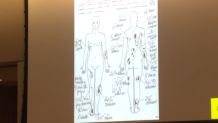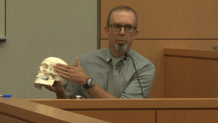Over the course of a couple of hours, jurors were shown dozens of photos from the autopsy of Connie Dadkhah. Greg Pizarro, M.D., a San Diego County deputy medical examiner, testified about numerous bruises, scrapes and cuts to Dadkhah's body.
Deputy district attorney Martin Doyle asked, “There are so many injuries you needed two different diagrams to document them?”
“Yes," Pizarro replied. “I counted a total of 51 injuries."
Pizarro, who is a board-certified forensic pathologist, acknowledged that number was low because medical examiners often group injuries together. Dadkhah had bruises on her face and neck, and a bad cut on her head. She also had injuries to her hands and arms, which Pizzaro said were consistent with defensive injuries.

“They are injuries in the arms,” Pizarro testified. “You are trying to shield yourself from further injury.”
Prosecutors say those were inflicted on June 14, 2022, when Parrish Chambers Jr. beat Dadkhah to death inside her condo. He’s pleaded not guilty.
Pizarro also noted bruises to her neck, saying it indicated Dadkhah was strangled. However, he said strangulation wasn’t the cause of death. He said that was fully determined from the second part of the autopsy, which involved an examination of Dadkhah's skull and brain. Graphic images of her skull showed a series of cracks, some of which stretched across her entire head.
“You can see temporal fractures here, which are consistent with a blow to the head,” Pizarro said. “The cause of death is multiple blunt force injuries, especially to the head.”
Another expert in forensics took the stand afterward. Jeremy Deisch, M.D., is certified in neuropathology and examined sections of Dadkhah's brain. He said he found evidence that her injuries caused extensive brain bleeds and a fairly large blood clot in the brain.
"The primary finding in this case was bleeding in multiple areas of the brain,” Deisch testified. “Bleeding in the thin layer that surrounds the outside of the brain. It was fresh, acute, meaning it hadn’t been around very long."

Chambers’ public defender Abe Genser cross-examined both witnesses. Both experts agreed that many of the injuries to Dadkhah's body could have happened up to three days before she died and that it was possible Dadkhah could have fallen and hit her head and survived that trauma.
Genser argued that some of the bruises could have been hickies. While Genser says his client did break into Dadkhah's condo, he says the two reconciled after the attack, had sex and did drugs. Pizarro acknowledged that some bruises could have been produced that way.
Genser has argued that Dadkhah and Chambers had a tumultuous sexual relationship that included drug use. Dadkhah's friends say she met Chambers through her volunteer work with mental health outreach. They say he became smitten with her, tracked down her address and constantly visited despite repeated requests that Chambers leave her alone.
Pizarro also testified that other tests were performed on Dadkhah, which ruled out sexual assault.
Blood spatter analysis, DNA testing featured heavily during testimony
Later in the day, San Diego Police Department criminalist Jodi Brown took the stand. The prosecution walked her through an exhaustive list of blood evidence. She told the court that DNA testing revealed that all of the blood samples collected throughout the condo had an incredibly high likelihood of being connected to Chambers and not Dadkhah. That included on walls, on the floor, on the bathroom counter, in the kitchen and on clothing.
Deputy district attorney Trisha Amador asked the witness if that indicated that Dadkhah never left the spot on the couch where she was found dead.
“What if a person is not moving around?” Amador asked. “Would you expect them to be depositing blood all over the house?”
“No,” Brown answered.
“What if a person is dead?” Amador asked. “Would you expect them to be moving around?”
“No,” Brown answered.
Brown also testified how blood spatter can reveal the direction in which it’s flung against objects. She said that’s visible in the shape of blood droplets. If blood is flung at an angle, the droplet looks more like an oval, compared to a round dot if it’s thrown from a straight line.

Brown said the blood stains on the walls near Dadkhah showed droplets landed from many different angles, indicating there were several events where blood was scattered. During cross-examination from Genser, Brown acknowledged there was no way to know how the blood was thrown, and that it was possible Chambers was simply shaking one of his hands that had a cut on it. Next, during redirection from Amador, Brown said it was possible that spatter came from somebody swinging with their fists.
“Is it also possible, a scenario, where somebody is swinging down in a motion, and blood casts off?” Amador asked.
“Yes,” Brown answered.
Click here to read up on what happened during the other days of the murder trial. You can also watch replays of each day's proceedings the weekday after they happen, starting at 11:30 a.m.
Background on the murder case

On the morning of June 15, 2022, prosecutors say Chambers emerged from Dadkhah's condo, spattered with her blood. They say he flagged down a neighbor to call 911 to report that she was dead inside. He was taken into custody soon after and charged with her murder.
But it’s what happened the night before that has her family, friends and neighbors questioning whether her death could have been prevented.
Police dispatch records show around 7 p.m. on June 14, 2022, Dadkhah's neighbors began calling 911. They begged police to get there quickly, reporting that a belligerent man was trying to break into a woman’s condo. Initially, the call wasn’t prioritized. About an hour later, callers had new information to tell dispatchers: the man had scaled a wall to her second-floor balcony and smashed his way inside through a sliding glass door. While police upgraded the call to a higher priority, it took another 45 minutes for officers to arrive at the complex.
Those same dispatch records, along with court filings from prosecutors, reveal what happened next. Officers tried to make contact with Dadkhah by calling her phone, knocking on her door and using a loudspeaker. But officers left the scene 15 minutes later after failing to make contact with anyone inside. There’s no record of Dadkhah calling police that night.
Previous coverage:
In defending their decision not to force entry the night before, police told NBC 7 Investigates they had reason to believe that Chambers lived there. That was based on a dispatch record accessed by responding officers. Police also told NBC7 the decision to force entry into anyone’s home shouldn’t be taken lightly and is among the highest level of legal standards they operate under.
But Chambers didn’t live there, though NBC 7's investigation revealed a lengthy history between the two. Court filings show that included an incident in 2020, where Chambers was convicted of vandalism. The judge ordered Chambers to stay away from Dadkhah.
In addition to the murder charge, prosecutors also charged Chambers with three other crimes where they say Dadkhah was his victim. That includes two counts of battery and one count of false imprisonment. He’s pleaded not guilty to those counts as well.
How to watch the trial
NBC 7 will be in court every day to bring you full coverage of all the big moments. That includes playing back the previous day’s trial proceedings starting at 11:30 a.m. The judge in the case ruled that live broadcasts from the courtroom aren’t allowed.
Watch the murder trial on NBC7.com or NBC San Diego News streaming platforms (including Roku, Peacock and Samsung TV). And come back for coverage and analysis every night of the trial at 4 p.m. and 6 p.m.



